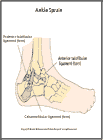
Ankle Sprain
What is an ankle sprain?
An ankle sprain is an injury that causes a stretch or tear of one or more ligaments in the ankle joint. Ligaments are strong bands of tissue that connect bones at the joint.
Sprains may be graded I, II, or III depending on their severity:
- grade I sprain: pain with minimal damage to the ligaments
- grade II sprain: more ligament damage and mild looseness of the joint
- grade III sprain: complete tearing of the ligament and the joint is very loose or unstable.
Sometimes sprains are just classified as mild or severe, depending on the amount of ligament damage.
Most sprains occur on the outside part of the ankle, but they can occur on the inside as well.
How does it occur?
A sprain is caused by twisting your ankle. Your foot usually turns in or under but may turn to the outside.
What are the symptoms?
Symptoms of a sprained ankle include:
- mild aching to sudden pain
- swelling
- discoloration
- inability to move the ankle properly
- pain in the ankle even when you are not putting any weight on it.
How is it diagnosed?
To diagnose a sprained ankle, the health care provider will review how the injury occurred and consider your symptoms. He or she will examine your ankle carefully. X-rays may be taken of your ankle.
How it is treated?
Treatment may include:
- Applying ice packs to your ankle for 20 to 30 minutes every 3 to 4 hours for the first 2 to 3 days or until the pain goes away. Thereafter, ice your ankle at least once a day until the other symptoms are gone.
- Elevating your ankle by placing a pillow underneath your foot. Try to keep your ankle above the level of your heart.
- Wrapping an elastic bandage around your ankle to keep the swelling from getting worse.
- Wearing a lace-up brace or ankle stirrup (an Aircast or Gel cast).
- Using crutches until you can walk without pain.
- Taking anti-inflammatory medication, such as ibuprofen, or other pain medication prescribed by your provider.
- Doing ankle exercises to improve your ankle strength and range of motion. The exercises will help you return to your normal activity or sports.
Rarely, severe ankle sprains with complete tearing of the ligaments need surgery. After surgery your ankle will be in a cast for 4 to 8 weeks.
How long will the effects last?
The length of recovery depends on many factors:
- age
- health
- severity of injury and previous injuries to that joint.
When can I return to my sport or activity?
The goal of rehabilitation is to return you to your sport or activity as soon as is safely possible. If you return too soon you may worsen your injury, which could lead to permanent damage. Everyone recovers from injury at a different rate. Return to your sport or activity will be determined by how soon your ankle recovers, not by how many days or weeks it has been since your injury occurred. In general, the longer you have symptoms before you start treatment, the longer it will take to get better.
You may safely return to your sport or activity when, starting from the top of the list and progressing to the end, each of the following is true:
- You have full range of motion in the injured ankle compared to the uninjured ankle.
- You have full strength of the injured ankle compared to the uninjured ankle.
- You can jog straight ahead without pain or limping.
- You can sprint straight ahead without pain or limping.
- You can do 45-degree cuts, first at half-speed, then at full-speed.
- You can do 20-yard figures-of-eight, first at half-speed, then at full-speed.
- You can do 90-degree cuts, first at half-speed, then at full-speed.
- You can do 10-yard figures-of-eight, first at half-speed, then at full-speed.
- You can jump on both legs without pain and you can jump on the injured leg without pain.
How can I help prevent an ankle sprain?
To help prevent an ankle sprain, follow these guidelines:
- Wear proper, well-fitting shoes when you exercise.
- Stretch gently and adequately before and after athletic or recreational activities.
- Avoid sharp turns and quick changes in direction and movement.
- Consider taping the ankle or wearing a brace for strenuous sports, especially if you have a previous injury.

